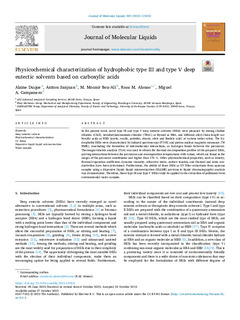Izenburua
Physicochemical characterization of hydrophobic type III and type V deep eutectic solvents based on carboxylic acidsBeste instituzio
A3Z Advanced Analytical Consulting ServicesUniversidad del País Vasco/Euskal Herriko Unibertsitatea (UPV/EHU)
Bertsioa
Bertsio argitaratua
Eskubideak
© 2023 The AuthorsSarbidea
Sarbide irekiaArgitaratzailearen bertsioa
https://doi.org/10.1016/j.molliq.2023.123431Non argitaratua
Journal of Molecular Liquids Vol. 392. Part 1. N. artículo 123431Argitaratzailea
ElsevierGako-hitzak
Deep eutectic solvent
Physicochemical characterization
UV filters
Dispersive liquid-liquid microextraction ... [+]
Physicochemical characterization
UV filters
Dispersive liquid-liquid microextraction ... [+]
Deep eutectic solvent
Physicochemical characterization
UV filters
Dispersive liquid-liquid microextraction
Water samples [-]
Physicochemical characterization
UV filters
Dispersive liquid-liquid microextraction
Water samples [-]
Laburpena
In the present work, novel type III and type V deep eutectic solvents (DESs) were prepared by mixing choline chloride (ChCl), tetrabutylammonium chloride (TBAC) or thymol as HBA, and different alkyl c ... [+]
In the present work, novel type III and type V deep eutectic solvents (DESs) were prepared by mixing choline chloride (ChCl), tetrabutylammonium chloride (TBAC) or thymol as HBA, and different alkyl chain length carboxylic acids as HBD (acetic, oxalic, palmitic, stearic, oleic and linoleic acid) at various molar ratios. The hydrophobic DESs were characterized by infrared spectroscopy (FT-IR) and proton nuclear magnetic resonance (1H NMR), concluding the formation of intermolecular interactions, as hydrogen bonds between the precursors. Thermogravimetric analysis (TGA) was used to obtain the thermal decomposition profiles of the prepared DESs, proving interactions between the precursors and decomposition temperatures with values, which are found in the ranges of the precursor constituents and higher than 170 °C. Other physicochemical properties, such as density, thermal expansion coefficient, dynamic viscosity, refractive index, surface tension, and thermal and ionic conductivities have been determined. Furthermore, the ability of these DESs as UV filter extractants from aqueous samples using a dispersive liquid–liquid microextraction (DLLME) previous to liquid chromatographic analysis was demonstrated. Therefore, these type III and type V DESs could be applied to the extraction of pollutants from environmental water samples. [-]
Finantzatzailea
Gobierno VascoGobierno Vasco
Gobierno Vasco
Gobierno Vasco
Gobierno Vasco
Programa
Programa Bikaintek 2020Ikasiker 2022-2023
Programa predoctoral (Investigación general) 2022
Ikertalde Convocatoria 2022-2025
Elkartek 2023
Zenbakia
021-B2-2020IT1673-22
PRE_2022_1_0136
IT1505-22
KK-2023-00016
Laguntzaren URIa
Sin informaciónSin información
Sin información
Sin información
Sin información
Proiektua
Sin informaciónSin información
Sin información
Mecánica de fluidos
Integrated advanced and sustainable microsystems for the smart and digital industry (µ4Smart)
Bildumak
Item honek honako baimen-fitxategi hauek dauzka asoziatuta:























